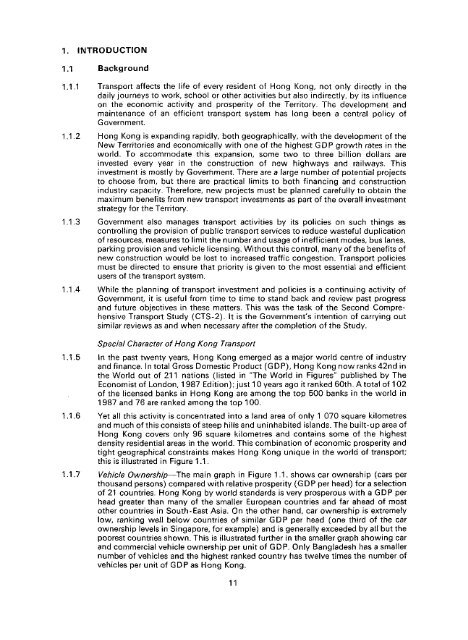Untitled - HKU Libraries - The University of Hong Kong
Untitled - HKU Libraries - The University of Hong Kong
Untitled - HKU Libraries - The University of Hong Kong
- No tags were found...
Create successful ePaper yourself
Turn your PDF publications into a flip-book with our unique Google optimized e-Paper software.
1.1.11.1.1 Transport affects the life <strong>of</strong> every resident <strong>of</strong> <strong>Hong</strong> <strong>Kong</strong>, not only directly in thedaily journeys to work, school or other activities but also indirectly, by its influenceon the economic activity and prosperity <strong>of</strong> the Territory. <strong>The</strong> development andmaintenance <strong>of</strong> an efficient transport system has long been a centra! policy <strong>of</strong>Government.1.1.2 <strong>Hong</strong> <strong>Kong</strong> is expanding rapidly, both geographically, with the development <strong>of</strong> theNew Territories and economically with one <strong>of</strong> the highest GDP growth rates in theworld. To accommodate this expansion, some two to three billion dollars areinvested every year in the construction <strong>of</strong> new highways and railways. Thisinvestment is mostly by Government. <strong>The</strong>re are a large number <strong>of</strong> potential projectsto choose from, but there are practical limits to both financing and constructionindustry capacity. <strong>The</strong>refore, new projects must be planned carefully to obtain themaximum benefits from new transport investments as part <strong>of</strong> the overall investmentstrategy for the Territory.1.1.3 Government also manages transport activities by its policies on such things ascontrolling the provision <strong>of</strong> public transport services to reduce wasteful duplication<strong>of</strong> resources, measures to limit the number and usage <strong>of</strong> inefficient modes, bus lanes,parking provision and vehicle licensing. Without this control, many <strong>of</strong> the benefits <strong>of</strong>new construction would be lost to increased traffic congestion. Transport policiesmust be directed to ensure that priority is given to the most essential" and efficientusers <strong>of</strong> the transport system.1.1.4 While the planning <strong>of</strong> transport investment and policies is a continuing activity <strong>of</strong>Government, it is useful from time to time to stand back and review past progressand future objectives in these matters. This was the task <strong>of</strong> the Second ComprehensiveTransport Study (CTS-2). it is the Government's intention <strong>of</strong> carrying outsimilar reviews as and when necessary after the completion <strong>of</strong> the Study.Special Character <strong>of</strong> <strong>Hong</strong> <strong>Kong</strong> Transport1.1.5 In the past twenty years, <strong>Hong</strong> <strong>Kong</strong> emerged as a major world centre <strong>of</strong> industryand finance, In total Gross Domestic Product (GDP), <strong>Hong</strong> <strong>Kong</strong> now ranks 42nd inthe World out <strong>of</strong> 211 nations (listed in "<strong>The</strong> World in Figures" published by <strong>The</strong>Economist <strong>of</strong> London, 1 987 Edition); just 10 years ago it ranked 60th. A total <strong>of</strong> 102<strong>of</strong> the licensed banks in <strong>Hong</strong> <strong>Kong</strong> are among the top 500 banks in the world in1987 and 76 are ranked among the top 100.1.1.6 Yet all this activity is concentrated into a land area <strong>of</strong> only 1 070 square kilometresand much <strong>of</strong> this consists <strong>of</strong> steep hills and uninhabited islands. <strong>The</strong> built-up area <strong>of</strong><strong>Hong</strong> <strong>Kong</strong> covers oniy 96 square kilometres and contains some <strong>of</strong> the highestdensity residential areas in the world. This combination <strong>of</strong> economic prosperity andtight geographical constraints makes <strong>Hong</strong> <strong>Kong</strong> unique in the world <strong>of</strong> transport;this is illustrated in Figure 1.1.1.1.7 Vehicle Ownership—<strong>The</strong> main graph in Figure 1.1. shows car ownership (cars perthousand persons) compared with relative prosperity (GDP per head) fora selection<strong>of</strong> 21 countries. <strong>Hong</strong> <strong>Kong</strong> by world standards is very prosperous with a GDP perhead greater than many <strong>of</strong> the smaller European countries and far ahead <strong>of</strong> mostother countries in South-East Asia. On the other hand, car ownership is extremelylow, ranking well below countries <strong>of</strong> similar GDP per head (one third <strong>of</strong> the carownership levels in Singapore, for example) and is generally exceeded by all but thepoorest countries shown. This is illustrated further in the smaller graph showing carand commercial vehicle ownership per unit <strong>of</strong> GDP. Only Bangladesh has a smallernumber <strong>of</strong> vehicles and the highest ranked country has twelve times the number <strong>of</strong>vehicles per unit <strong>of</strong> GDP as <strong>Hong</strong> <strong>Kong</strong>.11
















